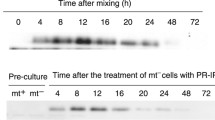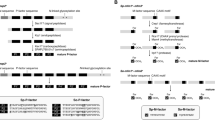Abstract
A new IS element, IS1062, related to the enterococcal IS elements IS6770 and IS1252, was detected in the 3′-terminus of the surface exclusion gene,sep1, of sex pheromone plasmid pPD1 inEnterococcus faecalis. pPD1-bearing cells lack the surface exclusion function, probably as a consequence of this insertion. Analysis of pAD1 and pPD1 sequences (7.5 kb and 2.7 kb, respectively) downstream of their aggregation substance genes revealed no similarity in these DNA regions. Detailed DNA/DNA hybridization studies using DNA probes specific for various pAD1-encoded genes needed for plasmid transfer indicated that the sex pheromone plasmids have evolved by repeated recombination and insertion of diverse transposable elements which presumably account for recent acquisition of antibiotic resistances.
Similar content being viewed by others
References
Brantl S (1994) ThecopR gene product of plasmid pIP501 acts as a transcriptional repressor at the essentialrepR promotor. Mol Microbiol 14:473–483
Ceglowski P, Alonso JC (1994) Gene organization of theStreptococcus pyogenes plasmid pDB101: sequence analysis of theorfη-copS region. Gene 145:33–39
Christie PJ, Korman RZ, Zahler SA, Adsit JC, Dunny GM (1987) Two conjugation systems associated withStreptococcus faecalis plasmid pCF10: identification of a conjugative transposon that transfers betweenS. faecalis andBacillus subtilis. J Bacteriol 169:2529–2536
Clewell DB (1993)Bacterial Conjugation. Plenum Press, New York and London
Ehrenfeld EE, Clewell DB (1987) Transfer functions of theStreptococcus faecalis plasmid pAD1: organization of plasmid DNA encoding response to sex pheromone. J Bacteriol 168:6–12
Fujimoto S, Tomita H, Wakamatsu E, Tanimoto K, Ike Y (1995) Physical mapping of the conjugative bacteriocin plasmid pPD1 ofEnterococcus faecalis and identification of the determinant related to the pheromone response. J Bacteriol 177:5574–5581
Galli D, Wirth R (1991) Comparative analysis ofEnterococcus faecalis sex pheromone plasmids identifies a single homologous DNA region which codes for aggregation substance. J Bacteriol 173:3029–3033
Galli D, Friesenegger A, Wirth R (1992) Transcriptional control of sex-pheromone-inducible genes on plasmid pAD1 ofEnterococcus faecalis and sequence analysis of a third structural gene for (pPD1-encoded) aggregation substance. Mol Microbiol 6:1297–1308
Heaton MP, Discotto LF, Pucci MJ, Handwerger S (1996) Mobilization of vaucomycin resistance by transposon-mediated fusion of a vanA plasmid with anEnterococcus faecium sex pheromone-response plasmid. Gene 171:9–17
Hirt H, Wanner G, Galli D, Wirth R (1993) Biochemical, immunological and ultrastructural characterization of aggregation substances encoded byEnterococcuas faecalis sex-pheromone plasmids. Eur J Biochem 211:711–716
Hodel-Christian SL, Murray BE (1992) Comparison of the gentamycin resistance transpososn Tn5281 with regions encoding gentamycin resistance inEnterococcus faecalis isolates from different geographic locations. Antimicrob Agents Chemother 36:2259–2264
Ike Y, Craig RA, White BA, Yagi Y, Clewell DB (1983) Modification ofStreptococcus faecalis sex pheromones after acquisition of plasmid DNA. Proc Natl Acad Sci USA 80:5369–5373
Jacob AE, Hobbs SJ (1974) Conjugal transfer of plasmid-borne multiple antibiotic resistance inStreptococcus faecalis var.zymogenes. J Bacteriol 117:360–372
Kao S-M, Olmsted SB, Viksnins AS, Gallo JC, Dunny GM (1991) Molecular and genetic analysis of a region of plasmid pCF10 containing positive control genes and structural genes encoding surface proteins involved in pheromone-inducible conjugation inEnterococcus faecalis. J Bacteriol 173:7650–7664
Murray BE, Singh KV, Ross RP, Heath JD, Dunny GM, Weinstock GM (1993) Generation of restriction map ofEnterococcus faecalis OG1 and investigation of growth requirements and regions encoding biosynthetic functions. J Bacteriol 175:5216–5223
Muscholl A, Galli D, Wanner G, Wirth R (1993) Sex pheromone plasmid pAD1-encoded aggregation substance ofEnterococcus faecalis is positively regulatedin trans bytraE1. Eur J Biochem 214:333–338
Nakayama J, Nagasawa H, Isogai A, Clewell DB, Suzuki A (1990) Amino acid sequence of pheromone-inducible surface protein inEnterococcus faecalis, that is encoded on the conjugative plasmid pPD1. FEBS LETT 267:81–84
Nakayama J, Watarai H, Isogai A, Clewell DB, Suzuki A (1992) C-Terminal identification of AD74, a proteolytic product ofEnterococcus faecalis aggregation substance: application of liquid chromatography/mass spectrometry. Biosci Biotech Biochem 56:127–131
Navarre WW, Schneewind O (1994) Proteolytic cleavage and cell wall anchoring at the LPXTG motif of surface proteins in gram-positive bacteria. Mol Microbiol 14:115–121
Pansegrau W, Lanka E, Barth PT, Figurski DH, Guiney DG, Haas D, Helinski DR, Schwab H, Stanisich VA, Thomas CM (1994) Complete nucleotide sequence of Birmingham IncP alpha plasmids. J Mol Biol 239:623–663
Pontius LT, Clewell DB (1992) Regulation of the pAD1-encoded sex pheromone response inEnterococcus faecalis: nucleotide sequence analysis oftraA. J Bacteriol 174:1821–1827
Sanger F, Nicklen S, Coulson AR (1977) DNA sequencing with chain-terminating inhibitors. Proc Natl Acad Sci 74:5463–5467
Swinfield J, Oultram JD, Thompson DE, Brehm JK, Minton NP (1990) Physical characterization of the replication region of theStreptococcus faecalis plasmid pAMb1. Gene 87:79–90
Thorisdottir ASet al. (1994) IS6770, an enterococcal insertion-like sequence useful for determining the clonal relationship of clinical enterococcal isolates. J Infect Dis 170:1539–1548
Wang A, Macrina FL (1995) Streptococcal plasmid pIP501 has a functionaloriT site. J Bacteriol 177:4199–4206
Weaver KE, Clewell DB (1988) Regulation of the pAD1 sex pheromone response inEnterococcus faecalis: construction and characterization oflacZ transcriptional fusions in a key control region of the plasmid. J Bacteriol 170:4343–4352
Weidlich G, Wirth R, Galli D (1992) Sex pheromone plasmid pAD1-encoded surface exclusion protein ofEnterococcus faecalis. Mol Gen Genet 233:161–168
Wirth R (1994) The sex pheromone system ofEnterococcus faecalis: more than ‘just’ a plasmid-collection mechanism? Eur J Biochem 222:235–246
Wirth R, Olmsted S, Galli D, Dunny G (1991) Comparative analysis of cAD1- and cCF10-induced aggregation substances ofEnterococcus faecalis. In: Dunny GM, Cleary PP, McKay LL (eds) Genetics and Molecular Biology of Streptococci, Lactococci, and Enterococci. American Society for Microbiology, Washington DC, pp 34–38
Yanisch-Perron C, Vieira J, Messing J (1985) Improved M13 phage cloning vectors and host strains: nuclcotide sequences of the M13mp18 and pUC19 vectors. Gene 33:103–119
Author information
Authors and Affiliations
Additional information
Communicated by J. W. Lengeler
Rights and permissions
About this article
Cite this article
Hirt, H., Wirth, R. & Muscholl, A. Comparative analysis of 18 sex pheromone plasmids fromEnterococcus faecalis: detection of a new insertion element on pPD1 and implications for the evolution of this plasmid family. Molec. Gen. Genet. 252, 640–647 (1996). https://doi.org/10.1007/BF02173969
Received:
Accepted:
Issue Date:
DOI: https://doi.org/10.1007/BF02173969




